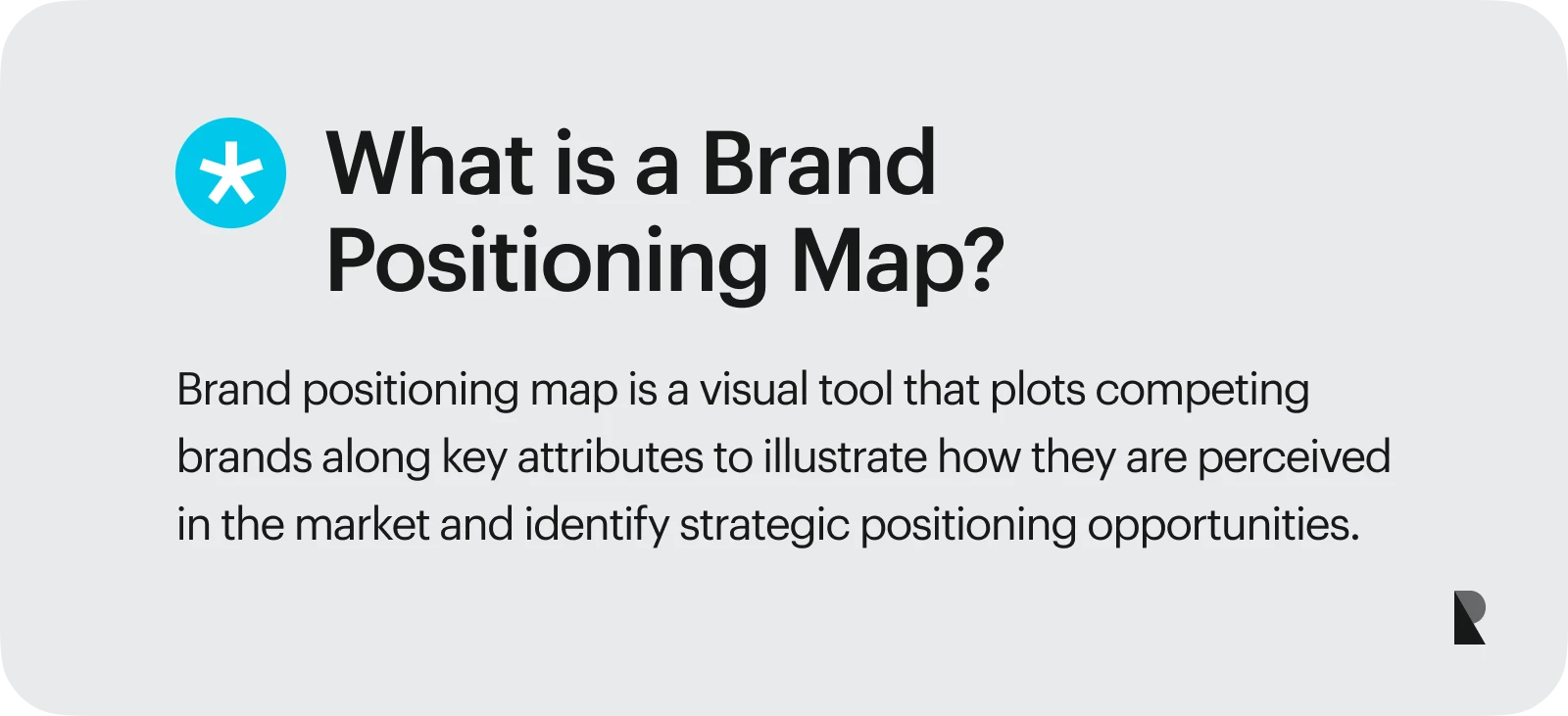
The market is like a complex maze with obstacles at every turn. Getting your brand where you want it to be is more challenging than tapping on Google Maps for directions.
Fortunately, there's a nifty tool you can use to guide you: the brand positioning map. This powerful tool can steer your brand toward more tremendous success and growth. Learn more about brand positioning maps, including real-life examples from the most prominent companies across the globe.
You can expose positioning gaps or voids your brand can fill and develop through a brand positioning map.
Say you are an emerging brand in the specialty coffee industry trying to figure out unique features that could win you more customers. However, you are competing against 12 other branded coffee shops with similar offerings. So, how can you stay ahead?
If you want to understand your competitors' market positions, you can create a brand position map that places them according to their different brand features. This process uncovers their strengths and weaknesses so you can develop a better brand strategy.
Let's further explore the benefits of a brand position map.
Key Benefits of a Brand Positioning Map
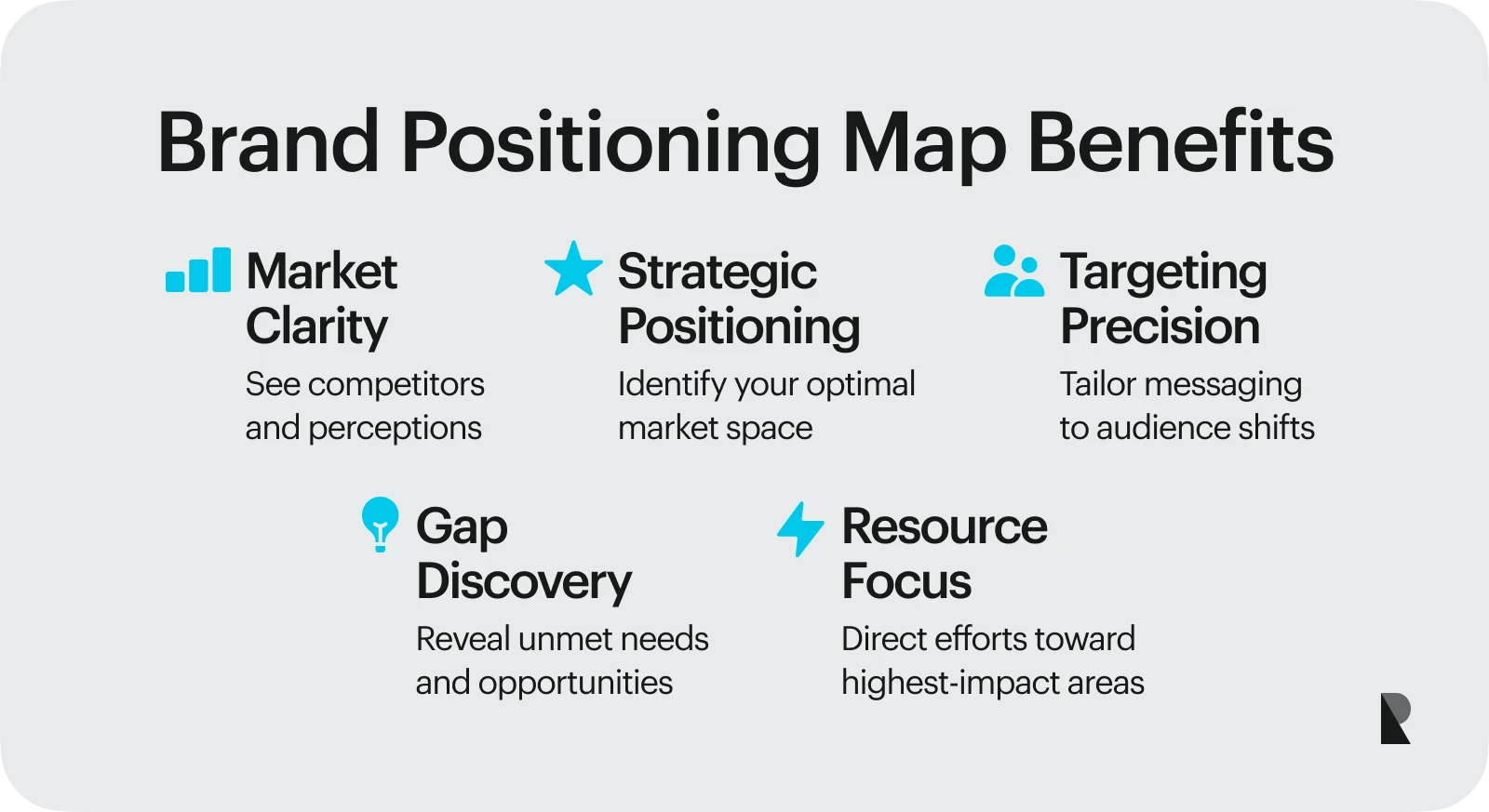
A brand positioning map is crucial for understanding the market and positioning your brand uniquely.
Finding the Best Spot on the Brand Position Map
If you want customers to notice you, avoid being bundled up with other branded products. The best strategy is to find a spot where your brand can shine and outcompete others. That's what a brand position map does.
Partnering with a corporate brand strategy agency can further clarify where your brand should stand in a crowded market. The brand position map gives you an overview of where to establish your branded products and services to optimize growth and resources based on your strengths.
Gain a Clear Understanding of the Market
The brand positioning map answers two questions about your brand and others:
- How good is the brand and its product or service?
- Does the quality of its branded offerings satisfy the price?
You can locate your competitors and see similarities and differences among branded products. The brand position map also helps companies understand what people like and dislike about your brand and its competitor's products.
Improved Targeting and Messaging
Brand positioning mapping alters whenever there's a change in demands and preferences. This is inevitable, especially in a volatile market.
That said, periodically updating a brand positioning mapping helps track trends, influences, and other activities. You can personalize your targeting strategy, branded products, messaging, marketing elements, and other efforts to reach your high-potential audience effectively.
Identification of Market Gaps
A brand position map helps uncover valuable gaps your branded products can exploit. Some of these are a demand for non-existing products and services at an affordable price, discrepancies in how people perceive your brand, and competitive attributes that other brands need to include.
A brand position map is often compared to a perception or perceptual map. While the brand position map considers a business's target audience, positioning statement, market dynamics, and other attributes, the perception map focuses on what customers think about a brand and its competitors.
Four Steps in Creating an Effective Brand Positioning Map
So, how can you draw a compelling brand positioning mapping for your business? Here are four fundamental steps to get you started.
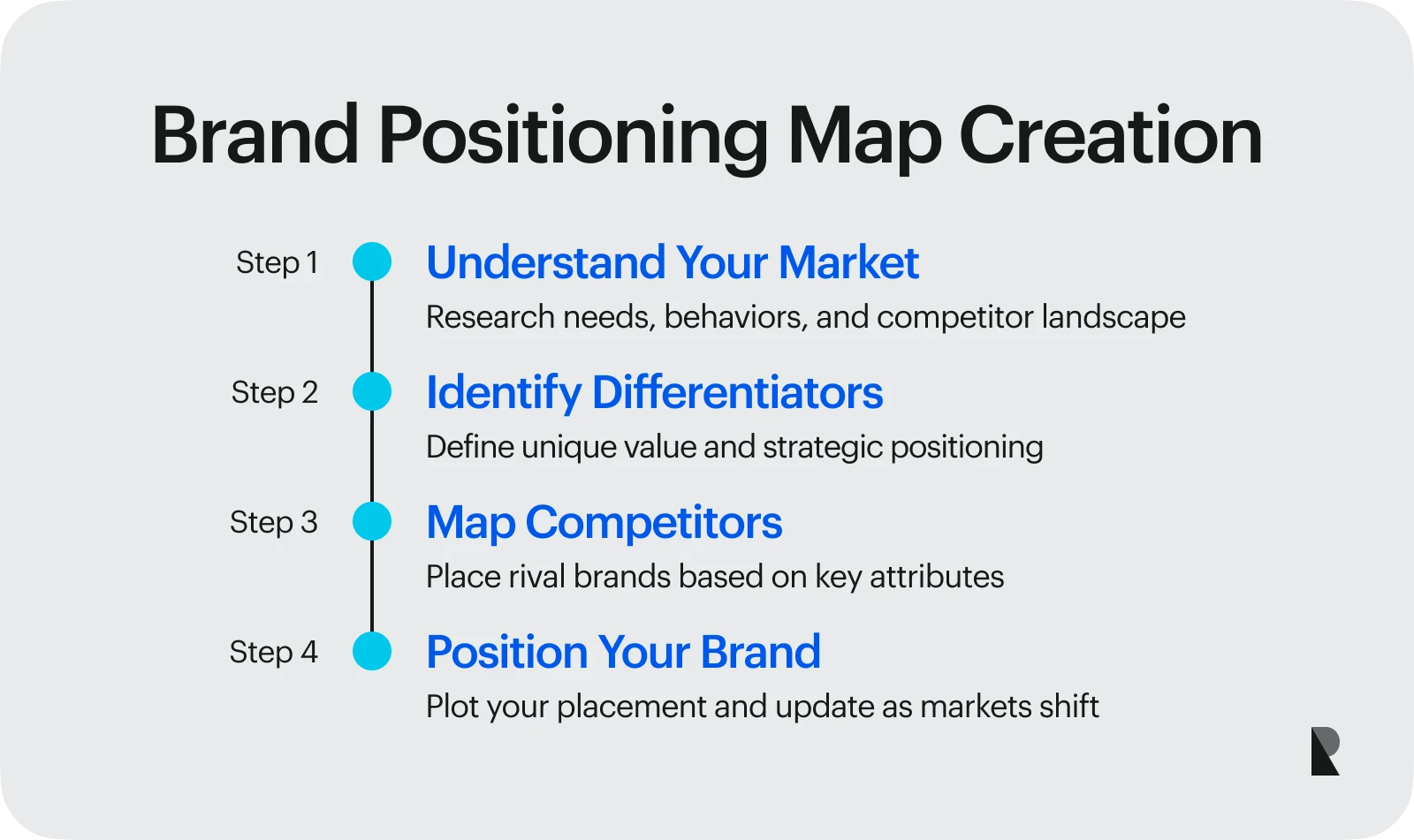
Step 1: Know Your Market
Creating a brand position map begins by knowing your target market inside out. This means focusing on what they want, their interests, critical problems, and expectations from branded products and services like yours.
At this stage, you can leverage surveys, focus group interviews, and social media listening tools to learn what target customers say about similar products and services online. You can also run a competitive analysis and A/B testing and review the history of your perceptual maps.
You can then create customer personas or profiles of your ideal customers to understand their pain points better. These insights and personas are crucial in drawing an efficient brand position map.
Step 2: Identify Key Differentiators
After thorough market research, you're ready to analyze and decide on key features that will set your brand apart. When determining your USP or Unique Selling Proposition, focus on features your competitors do not offer. Clearly articulate how these will benefit your customers in your unique value proposition—increased efficiency, better pricing, premium quality, etc.
For example, you can create a high-quality and high-priced local perfume, targeting a niche market looking for luxurious and exclusive fragrances. At this stage, you decide which route to take when establishing your market positioning in your brand position map.
Step 3: Plot Your Competitors
The brand positioning maps two axes (X-axis and Y-axis), representing different attributes you want to compare. One axis can represent low and high prices, while the other can represent low and high quality. You can find diverse map templates online, but a simple attribute matrix will suffice.
After gathering all the data from your research, identify competing brands you can place on the brand position map that target the same market segment as you. Analyze their positioning by examining how the market perceives them based on features, pricing, customer reviews, etc.
Step 4: Position Your Brand on the Map
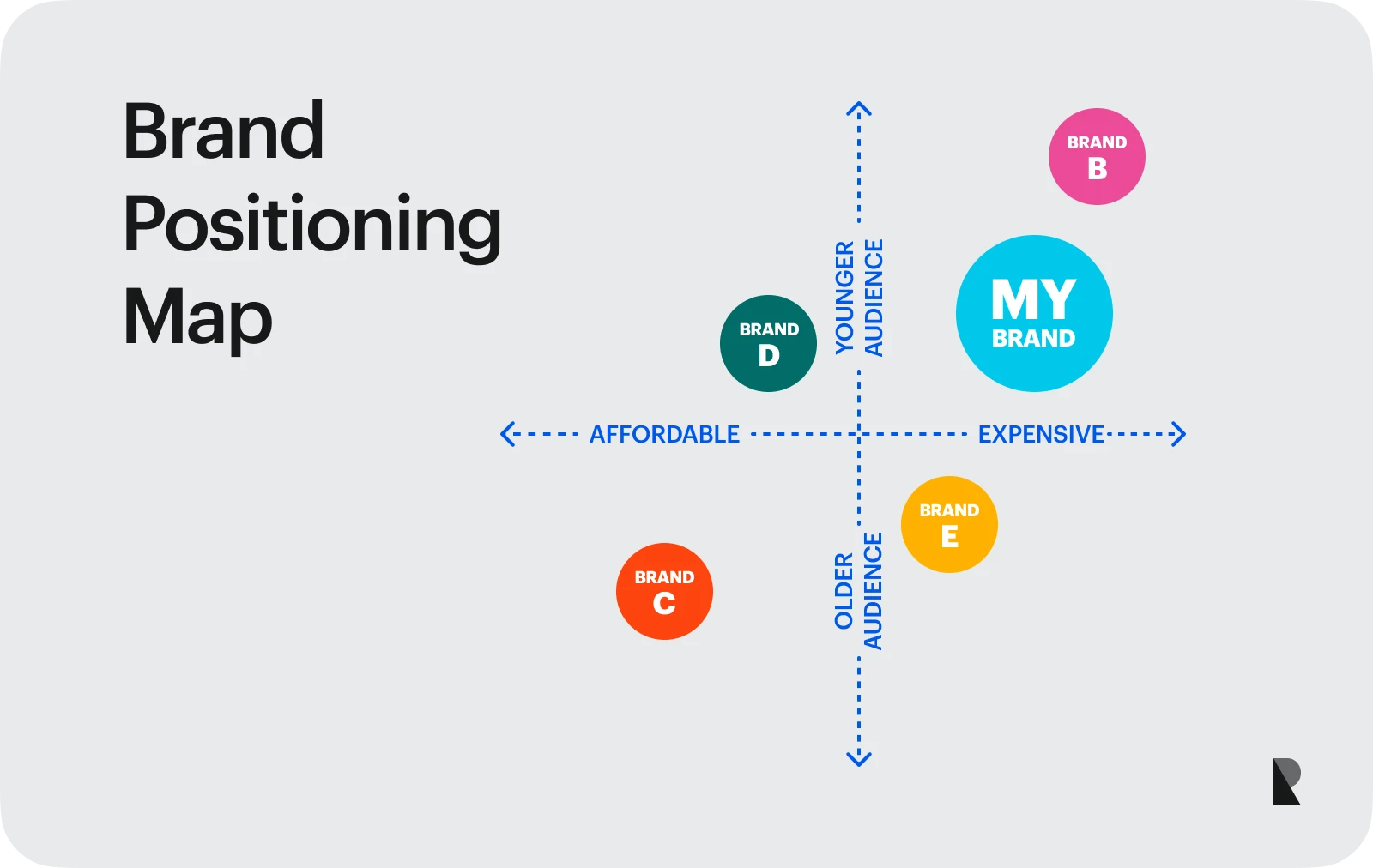
An example of a brand positioning map
When you've chosen the values for your axes, you can start placing your brand and its competitors in whichever quadrant they fit in. This gives you a bird' s-eye view of where everyone is regarding the two attributes you want to assess.
Do note that the market landscape changes, too. If you're targeting a young audience, behaviors and demands vary per generation. Consequently, your placement on the brand positioning map can also be different.
That said, it is essential to keep your brand positioning map updated. Stay on top of industry trends and the market pulse so you can adjust your brand positioning strategy accordingly. Compare your current brand position map and previous perceptual map to see if your goals align with your audience.
A proactive brand positioning approach allows you to stay ahead of the competition and evolve while remaining relevant to your target audience.
Real-World Brand Positioning Maps Examples and Analysis
Let's examine brand positioning map examples of some of the largest brands in the world to understand better how they work.
Who's winning the brand position map? How competitive are their selling points? And what strategies are they imposing to deliver on their mission statement?
Here's everything you need to know.
Apple vs. Samsung
First on our list are two tech giants known for their innovative smartphones: Apple and Samsung. These two brands make excellent products that attract buyers from different segments. However, they need to differentiate who they are targeting clearly.
If these two brands are friends, Apple is the fancy friend. It focuses on people looking for high-quality products despite their price point. Apple also does well in integrating a seamless user experience through its "ecosystem," which is exclusive to its users, and a simple design philosophy seen in its UI or user interface.
On the other hand, Samsung is a flexible friend who has something to offer everyone! The brand is known for its versatile devices built for all customers—the most advanced tech buyers, budget buyers, and mid-range buyers. Unlike Apple, Samsung has an "open ecosystem" that allows Android users to customize their experience.
Apple users are driven by exclusivity, luxury, and high loyalty. In contrast, Samsung users emphasize user-friendliness, variety, and value when purchasing phones. It has significantly advanced in releasing innovative smartphones, which Apple still needs to do in recent years. These differences in branded products shape their strategies and position in the market.
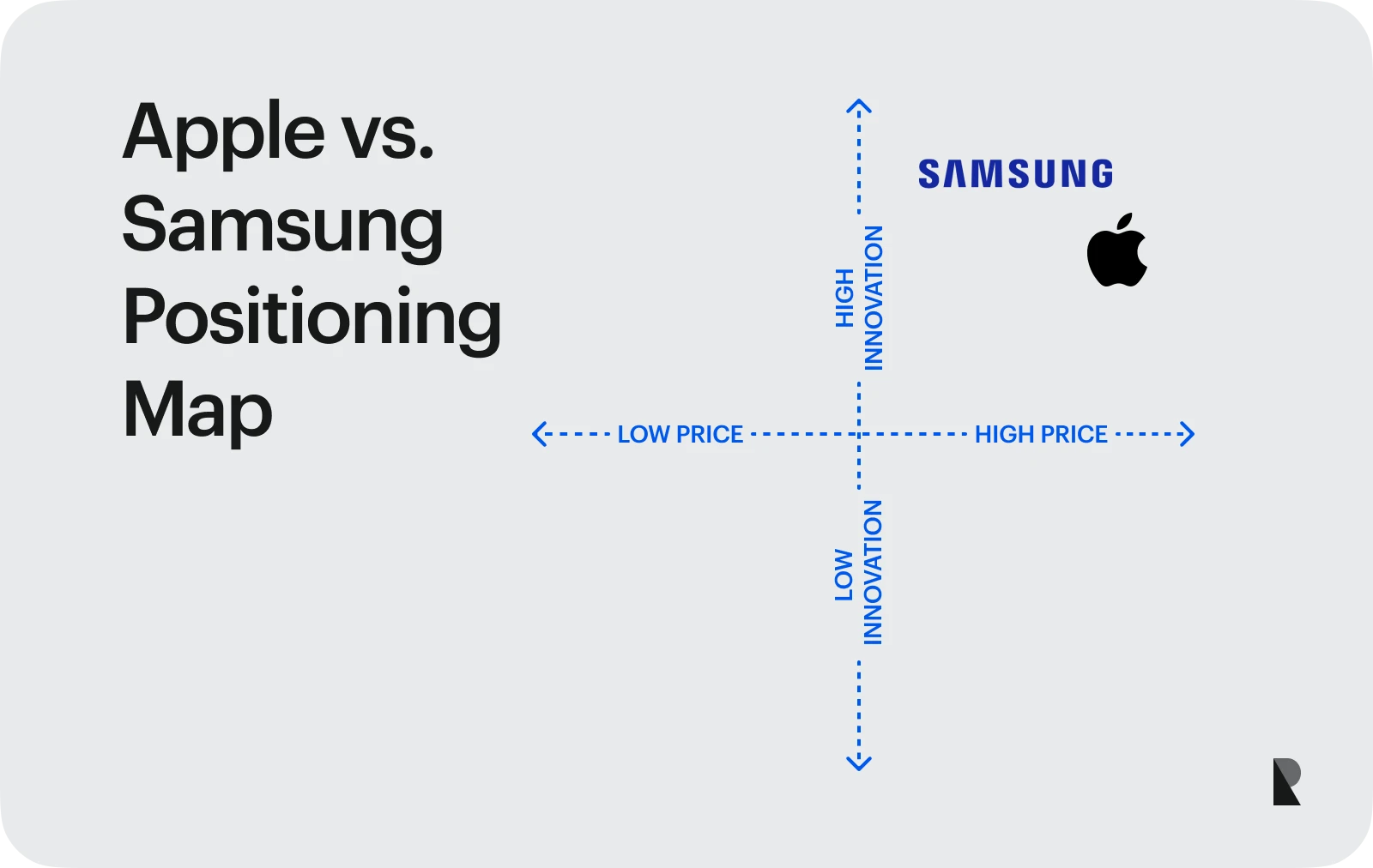
Brand positioning map comparing Apple and Samsung based on price and innovation
Coca-Cola vs. Pepsi
Coca-Cola has made a name for itself, being the go-to brand for carbonated drinks across generations for 125 years. Pepsi has always been one of the primary challengers of other branded cola products.
(Fun fact: Pepsi is older than Coca-Cola by five years, but it was only in the '70s that they were considered direct competitors.)
While they may serve customers similar products, they cater to slightly different audiences. For instance, Coca-Cola appeals to the young and old. The brand wants to cement itself as a classic choice of soda, focusing on evoking emotions like joy and happiness in every sip.
Meanwhile, Pepsi has a narrower market, tapping teens and young adults. With its refreshing and citrusy flavors, it is seen as more hip. If Coca-Cola wants to be seen as a classic choice, Pepsi is the fun and modern choice.
Both brands also compete in taste. Some say Pepsi has a sweet, fresh, and citrusy taste, while others like Coca-Cola's milder and smoother flavor. The argument of which cola tastes better is as old as time. In response, Pepsi took a bold step by conducting a blind taste test between its products and Coca-Cola's.
The result? The majority of the participants chose Pepsi. However, Coca-Cola is still the winning brand because of its vital cultural significance in the United States and consistent brand messaging worldwide.
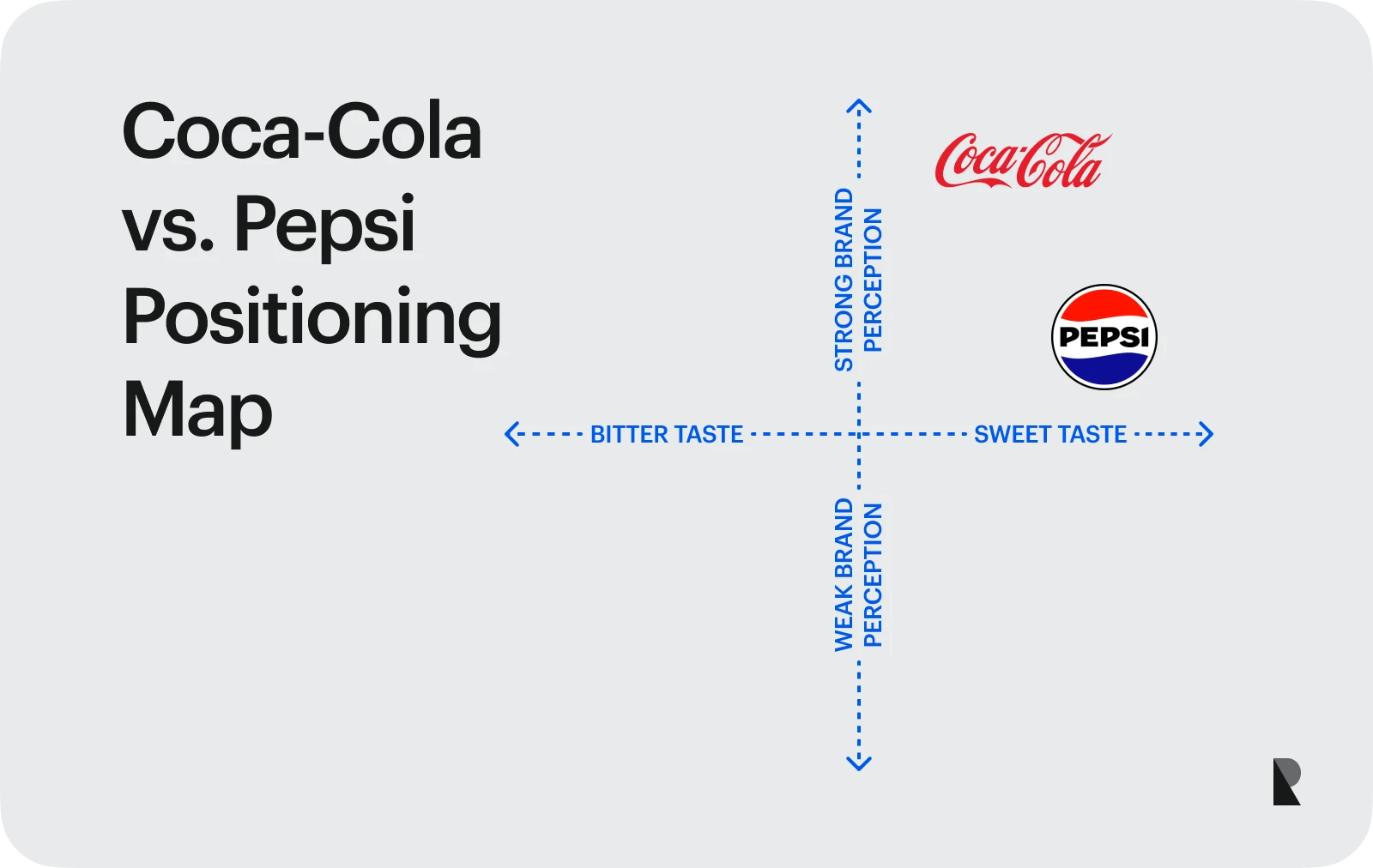
Brand positioning map comparing Coca-Cola and Pepsi based on taste and perception.
This Pepsi paradox has proven the power of holistic branding. Coca-Cola has unified all its products under the "One Brand" strategy, where other minor branded products (Coke Zero, Diet Coke, etc) benefit from the positive consumer perception and brand reputation of Coke Classic by having a unified packaging and marketing format.
Currently, Coca-Cola boasts a 69% US market share, while Pepsi is at 27%.
Adidas vs. Nike
Nike and Adidas have been pushing the boundaries of sportswear, bringing the industry to greater heights. Comparing the two is tough as they have become brand leaders in their own right.
But let's assess two features in our brand position map: athletic performance and pricing. x and y
Nike has earned a spot in the market as one of the go-to sports brands for athletes. Its focus on athleticism can be seen in its branding and marketing efforts, featuring high-profile athletes like Cristiano Ronaldo, Serena Williams, and Kobe Bryant. Nike also invests in branded sports technology, such as in its Nike Flyknit and Nike Air product lines, enhancing the performance of its users.
Adidas has a broader approach that appeals to both athletes and non-athletes. It is known for its lifestyle-focused designs, which gave rise to athleisure—shoes and apparel perfect for workouts, sports, and everyday use. Hence, the brand appeals to diverse consumer tastes.
Adidas has worked with celebrities in various fields, like Kanye West and Pharrell Williams. It has also tied up with local communities, promoting education and environmental causes.
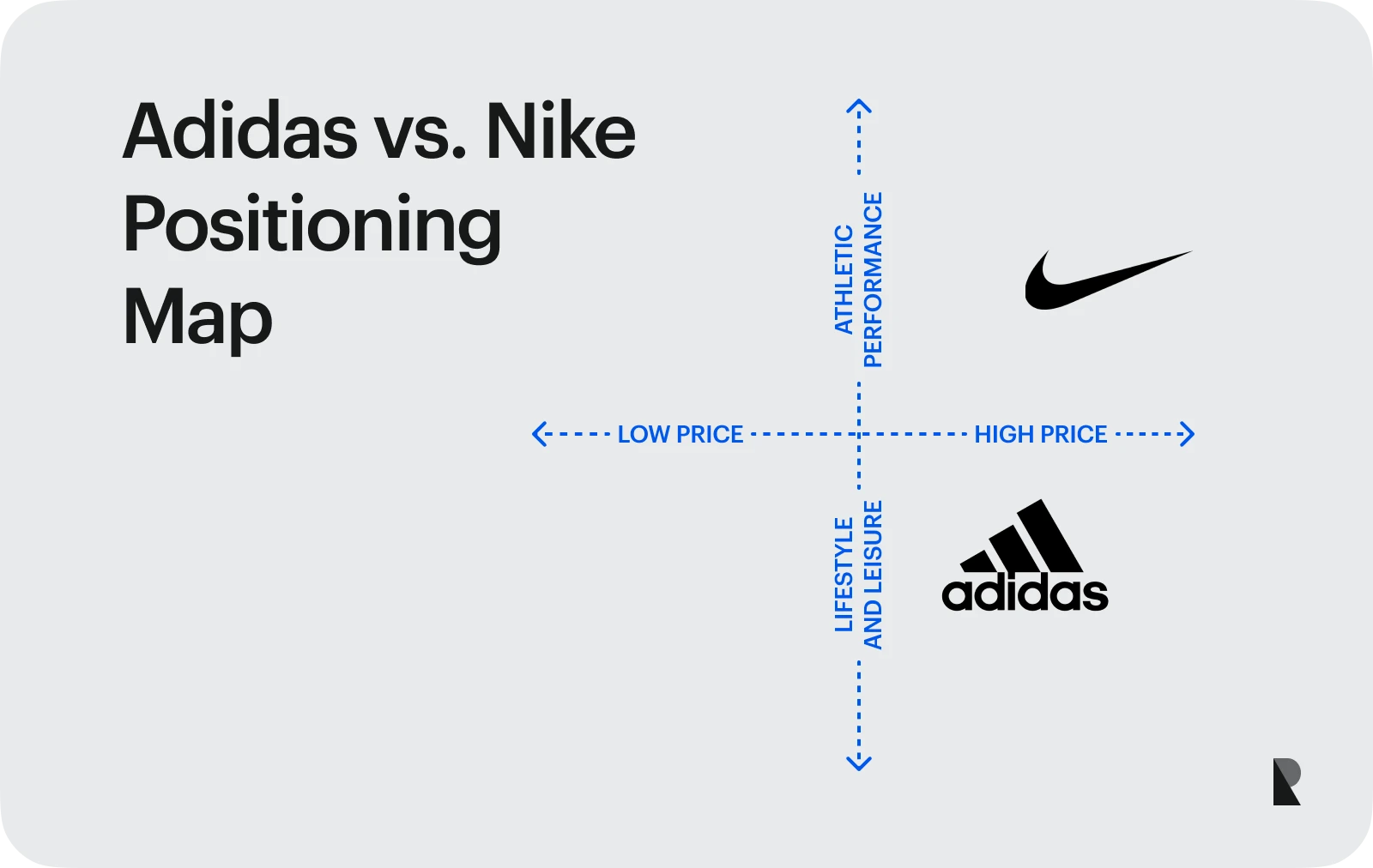
Brand positioning map comparing Adidas and Nike based on price and product design.
Both are considered premium brands when it comes to pricing. Adidas offers frequent discounts, making it more accessible than Nike. However, Nike dominates the market in the US and across the globe, generating about $29 billion in revenue. That said, Nike's current position is higher than Adidas.
Invest in a Brand Position Map for Success
A brand position map offers multiple benefits you should consider. It helps you understand your competitors' positions relative to your brand and exposes gaps you can fill.
However, leveraging this visual tool requires accuracy to optimize results. For instance, when refreshing your brand position map, consider how customers perceive you and your competitors. Be adept at creating strategies from the valuable insights you gather. Finally, effective brand maps can lead to data-driven insights, lessening your chances of committing mistakes.
Find the right path to success when you work with a well-experienced branding design firm on your brand position map. Let the experts save you time and resources as they lead you to your goals.
Nov 26, 2024
